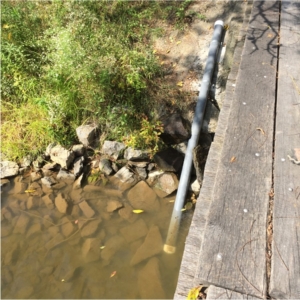A Masters student in hydrogeology at Pennsylvania State University is studying how nutrients like nitrates move from agricultural lands into local watersheds. Callum Wayman wanted to add an agricultural site to a group of constantly monitored sites run by the Susquehanna Shale Hills Critical Zone Observatory. He started field work in fall of 2016 by deploying sensors at a farm in Shaver’s Creek that measure stream stage, temperature, and electrical conductivity. He also continuously monitored surface water and groundwater.

Stilling well which is placed in shaver’s Creek and contains HOBO sensors which measure temperature, pressure, and electrical conductivity at 15 minute intervals.
He analyzes geochemical data from these water samples to understand how and where water and nutrients (nitrate, sulfate, calcium, etc.) are being transported. The goal is to understand how the land management practices at this farm are affecting local surface water, shallow groundwater, and regional groundwater which can flow into Shavers Creek. If this farm can be used as a template for land management practices for the other farms which come into contact with Shaver’s Creek, he hopes that they will be able to scale up their work at the farm to apply to the rest of Shaver’s Creek watershed.
His team wants to understand what can be done to mitigate the agricultural effects on regional groundwater and surface water quality in Shaver’s Creek and beyond. He hypothesized that the farm could potentially be adding nutrients that are flowing into the Juniata River, and in turn, the Susquehanna River. Understanding hydrological mechanisms in a small area will be key to for upscaling to larger watersheds that make up the Chesapeake Bay.
